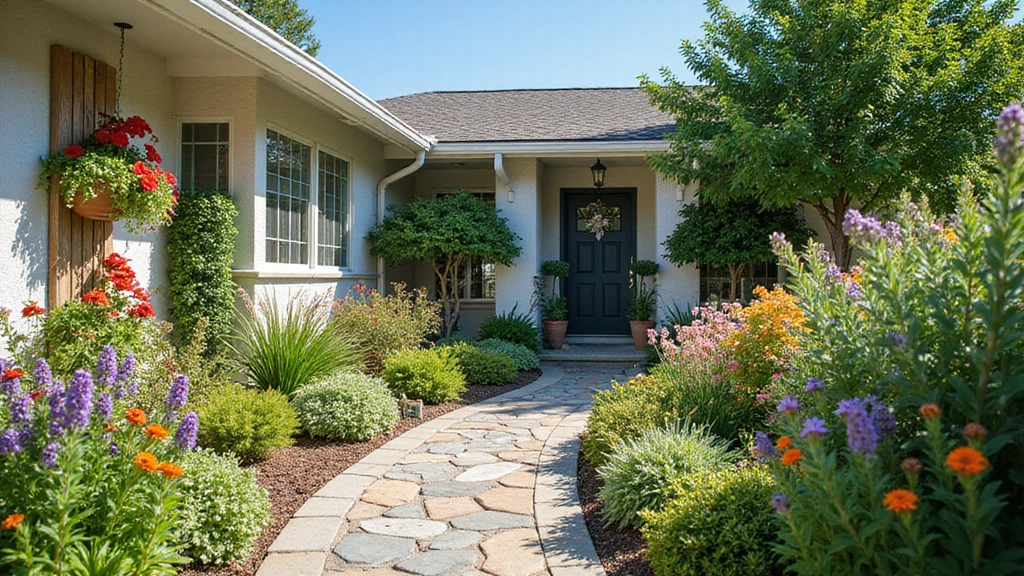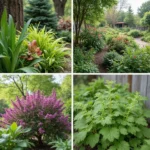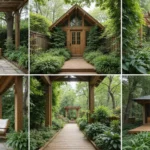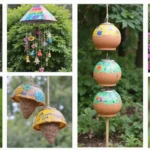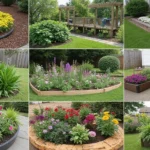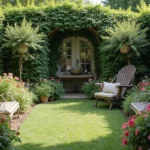Having a small front garden doesn’t mean you have to compromise on style or creativity. From vibrant vertical planters to elegant container gardens, your front yard can become an inviting space that enhances your home’s curb appeal.
With clever design choices and a splash of greenery, your limited space can truly shine. Whether you’re a gardening novice or a seasoned pro, these ideas will inspire your gardening journey and help you transform your small front garden into a stunning display of nature’s beauty. Let’s dive into these innovative small front garden ideas that pack a punch!
1. Vertical Garden Panels
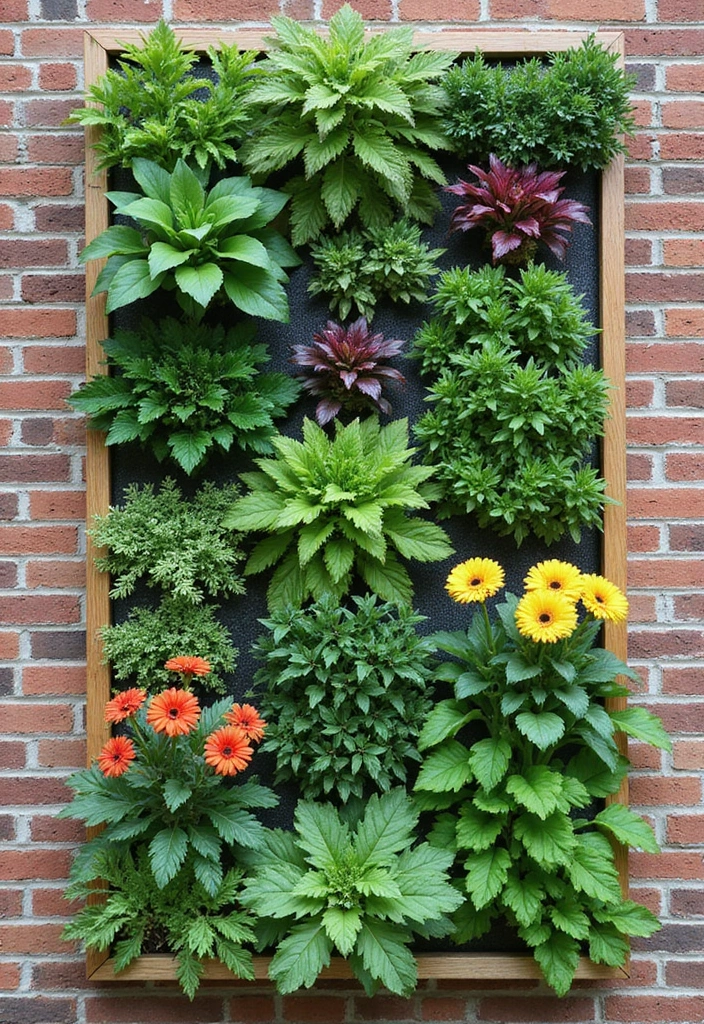
Vertical garden panels are a game-changer for small spaces. By utilizing wall-mounted systems, you can grow a variety of plants without sacrificing ground space. Imagine a wall adorned with herbs, succulents, or even flowering vines, creating a stunning backdrop.
– Choose the Right Plants: Opt for plants that thrive in vertical conditions, such as ferns or climbing plants.
– Create a Theme: Mix colors and textures for an eye-catching display, or stick to a monochrome palette for a sleek look.
– Easy Care: Vertical gardens can be low-maintenance with the right plants; just ensure they get enough light and water.
These panels not only beautify your garden but also contribute to improved air quality, creating a fresher environment for you and your family.
2. Tiered Planting Beds
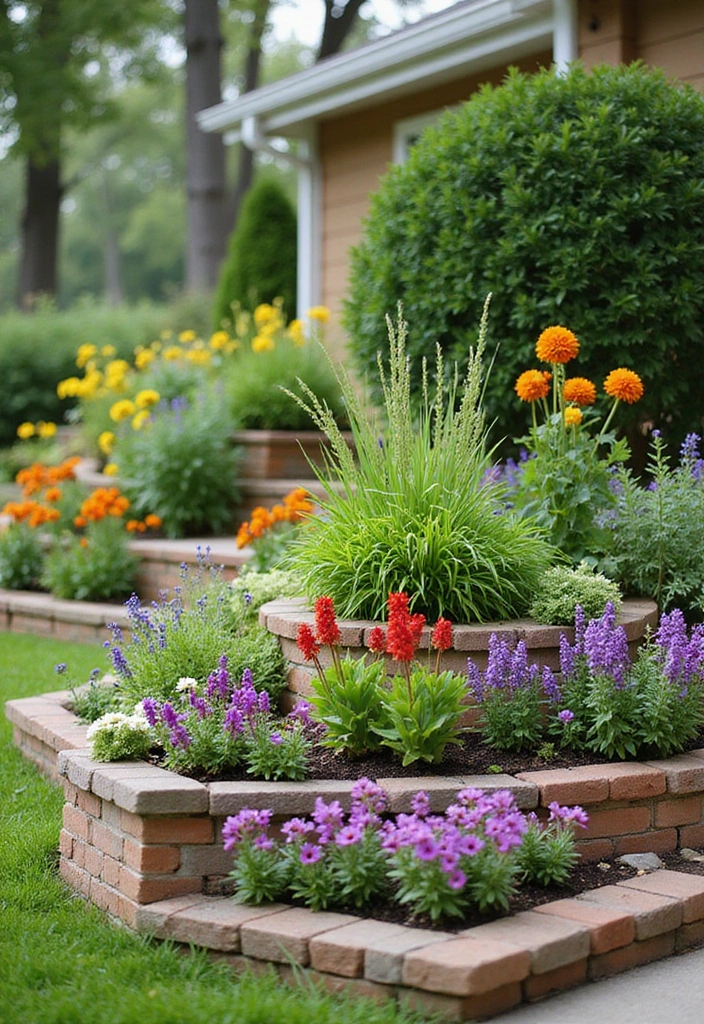
Tiered planting beds are an excellent way to add dimension and depth to your small front garden. These multi-level beds can host various plants, creating a visually appealing layout.
– Utilize Different Heights: Incorporate plants of various heights to attract the eye upwards, enhancing the perception of space.
– Mix Edible and Decorative Plants: Combine ornamental plants with edible varieties like strawberries or herbs for a practical yet beautiful garden.
– Easy Access: Tiered beds make it easier to tend to your plants, ensuring you can enjoy your garden without bending over too often.
These beds not only look good but also help with drainage and can be made using recycled materials for an eco-friendly option.
3. Container Gardening
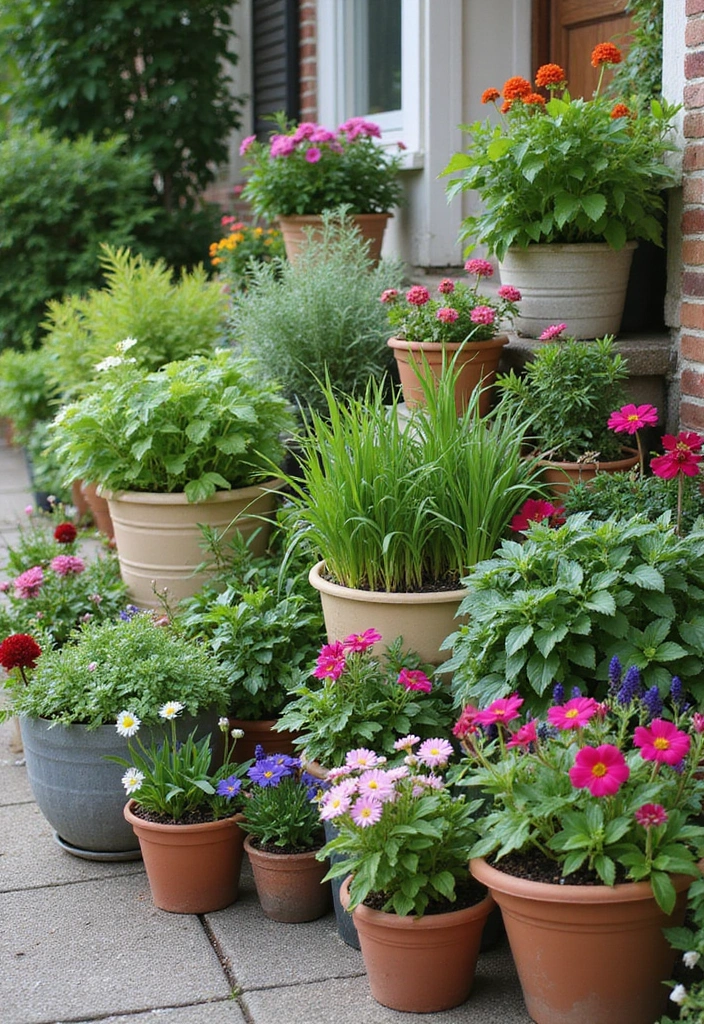
Container gardening is a fantastic solution for small front gardens. With a variety of pots available, you can mix and match sizes and colors to create a personalized display.
– Choose the Right Containers: Opt for lightweight materials like fiberglass for easy movement, or terracotta for a classic look.
– Diversity is Key: Use a mix of flowers, herbs, and even small shrubs to create texture and interest.
– Mobility: Containers can be moved to take advantage of sunlight or to change up the look of your garden whenever you wish.
Whether you have a small patio or just a patch of soil, container gardening allows you to express your creativity while maintaining a low-maintenance garden.
4. Decorative Pathways
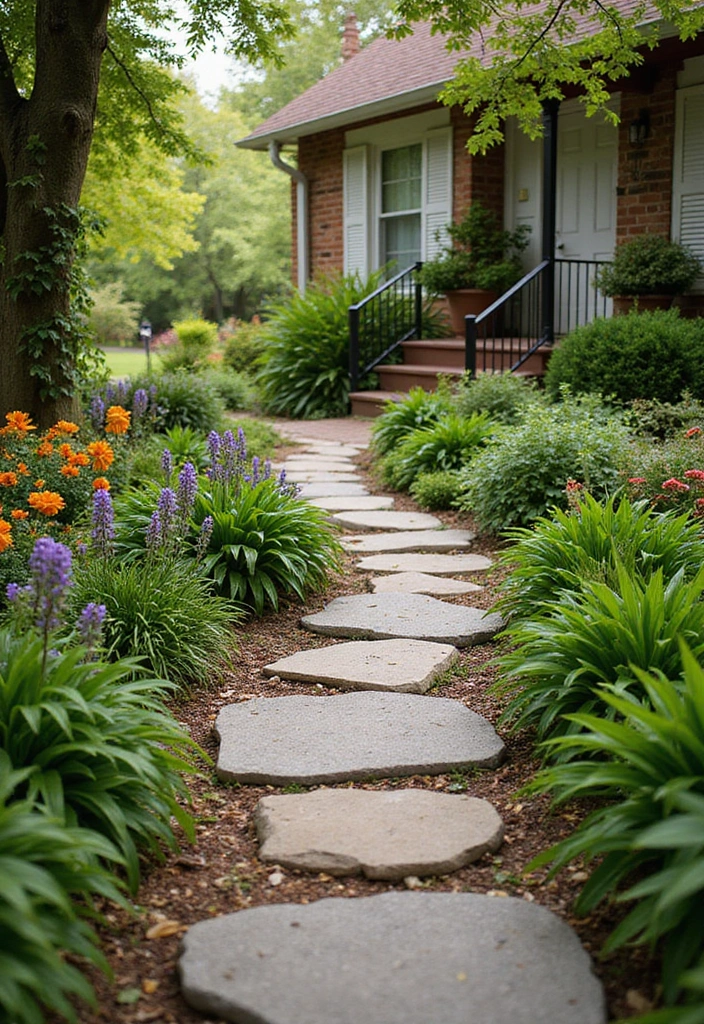
Creating a decorative pathway is a brilliant way to enhance the aesthetic of your small front garden. Paths not only lead visitors to your door, but they also guide the eye and add structure to your space.
– Materials Matter: Consider using stepping stones, gravel, or even wooden planks to create an inviting walkway.
– Add Borders: Incorporate plants or decorative stones along the edges for a polished look.
– Incorporate Curves: Avoid straight lines; instead, opt for gentle curves to create a more organic feel.
A well-designed pathway not only elevates the beauty of your garden but also provides a practical route without trampling over your precious plants.
5. Wall-Mounted Planters
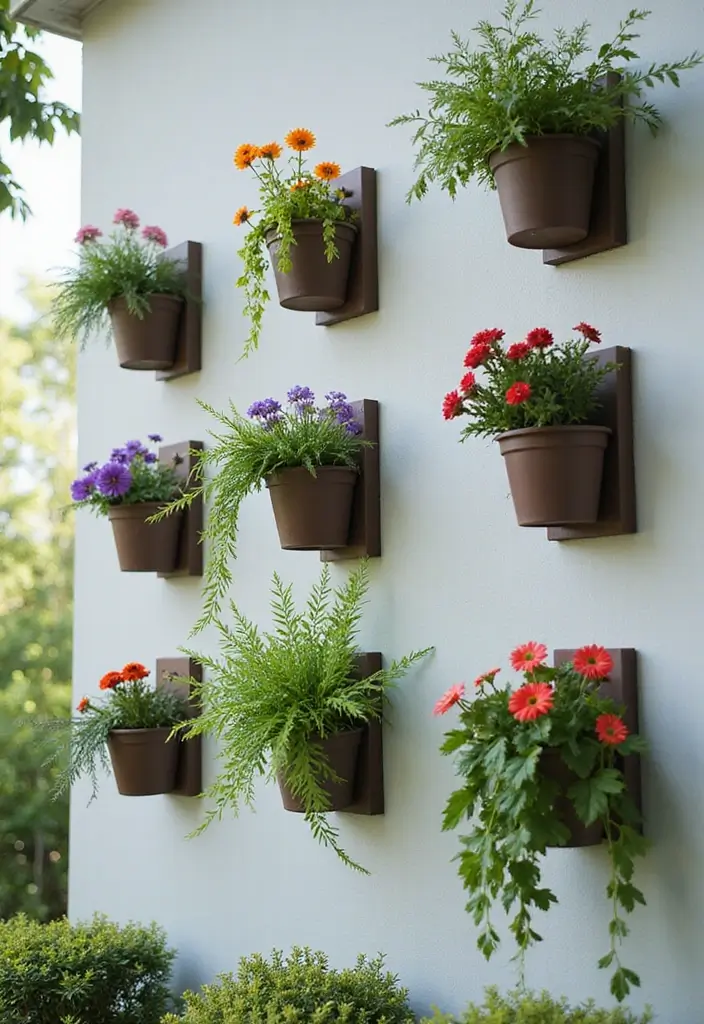
Wall-mounted planters offer a stylish way to incorporate greenery into limited spaces. They can be used on fences, walls, or even along the front of your home.
– Variety of Styles: Choose from wooden boxes, metal holders, or fabric pouches to suit your personal style.
– Select Versatile Plants: Herbs, trailing plants, or small flowers work wonderfully in wall-mounted settings.
– Create a Living Art Piece: Arrange multiple planters together for a striking visual effect that enhances your home’s exterior.
These planters are not only eye-catching but also functional, allowing you to maximize your planting space.
6. Minimalist Greenery
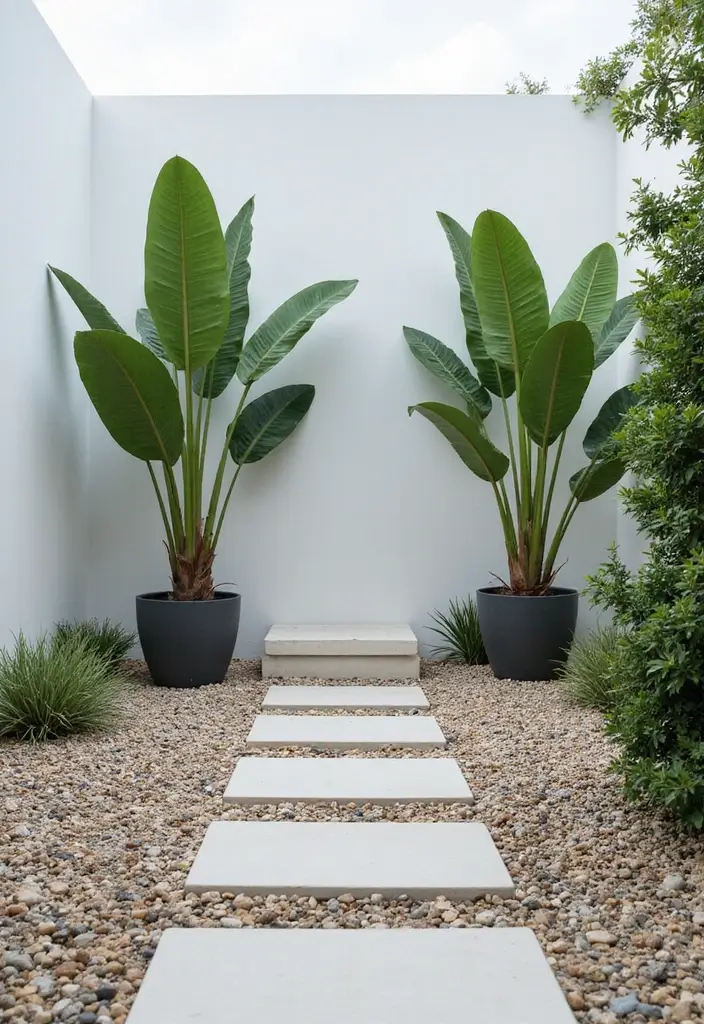
Sometimes less is more, especially in a small garden setting. A minimalist approach can create a serene and uncluttered space that feels expansive.
– Choose a Few Statement Plants: Focus on one or two larger plants or trees that stand out rather than filling every space with smaller plants.
– Incorporate Texture: Use plants with interesting leaves or textures to keep it engaging without overwhelming the senses.
– Consider Hardscaping: Integrate stones, pebbles, or gravel to balance out the greenery while adding elegance.
A minimalist garden provides a peaceful retreat that requires less maintenance but still makes a bold statement.
7. Colorful Plant Combinations
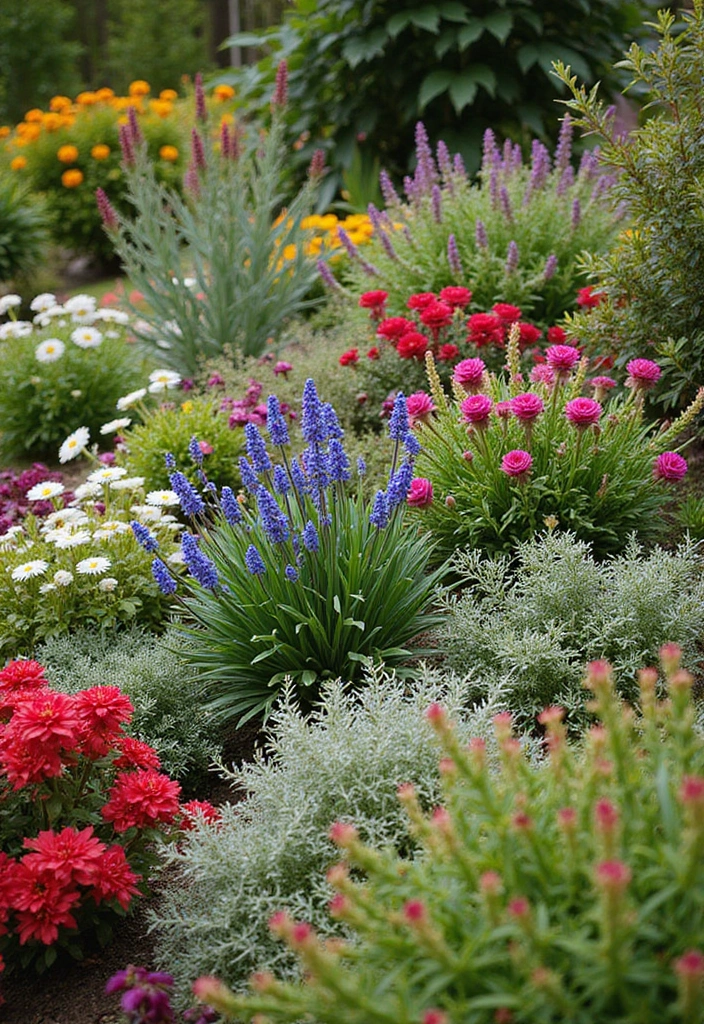
Creating colorful plant combinations can completely transform your small garden into a lively space. Vibrant colors naturally draw the eye and can make even the smallest area feel dynamic.
– Use Seasonal Blooms: Plant flowers that bloom at different times of the year to maintain color throughout the seasons.
– Contrast Textures: Mix lush foliage with delicate flowers for added visual interest.
– Experiment with Color: Try complementary colors to create a striking effect, such as purples with yellows or reds with greens.
By focusing on color combinations, you can ensure your garden remains bright and inviting, no matter the season.
8. Vertical Herb Gardens
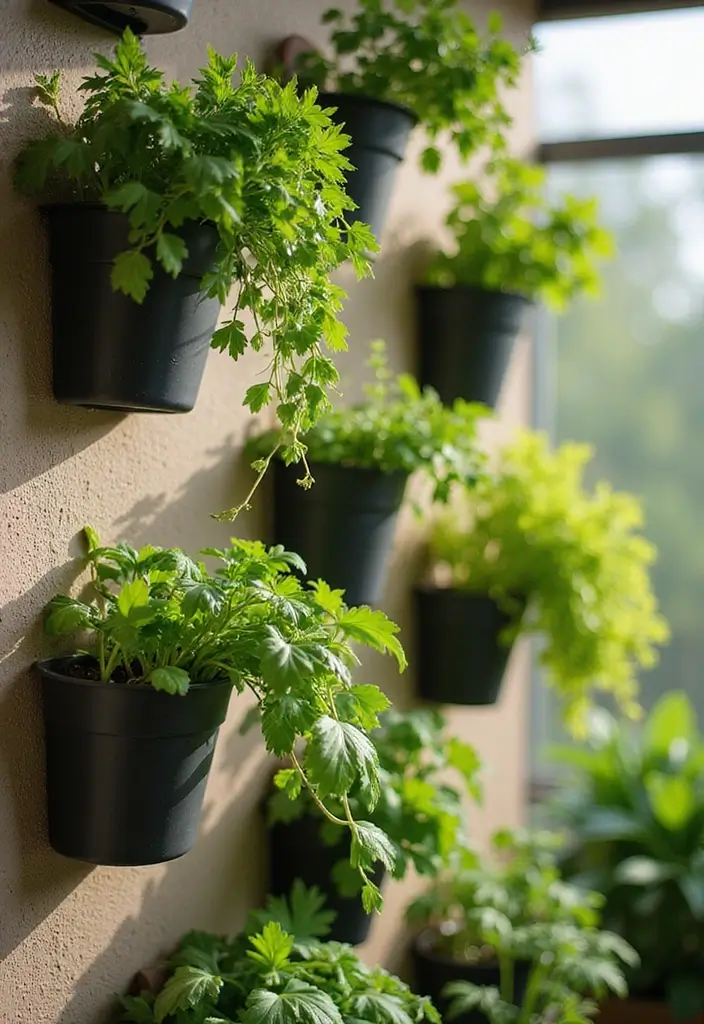
Vertical herb gardens are an ideal solution for those who love cooking with fresh ingredients. They not only save space but also keep herbs easily accessible right outside your door.
– Choose the Right Spot: Locate your herb garden where it can receive plenty of sunlight.
– Incorporate Wall Planters: Use wall-mounted containers or hanging baskets for a convenient herb garden setup.
– Mix and Match: Grow a variety of herbs that complement each other, such as basil, thyme, and rosemary.
With fresh herbs just a step away, your cooking will become even more delightful, and your garden will smell incredible too!
Elevate your small front garden with a vertical herb garden – not only do they save space, but they also bring fresh flavors right to your fingertips! Let your culinary adventures begin!
9. Repurposed Materials
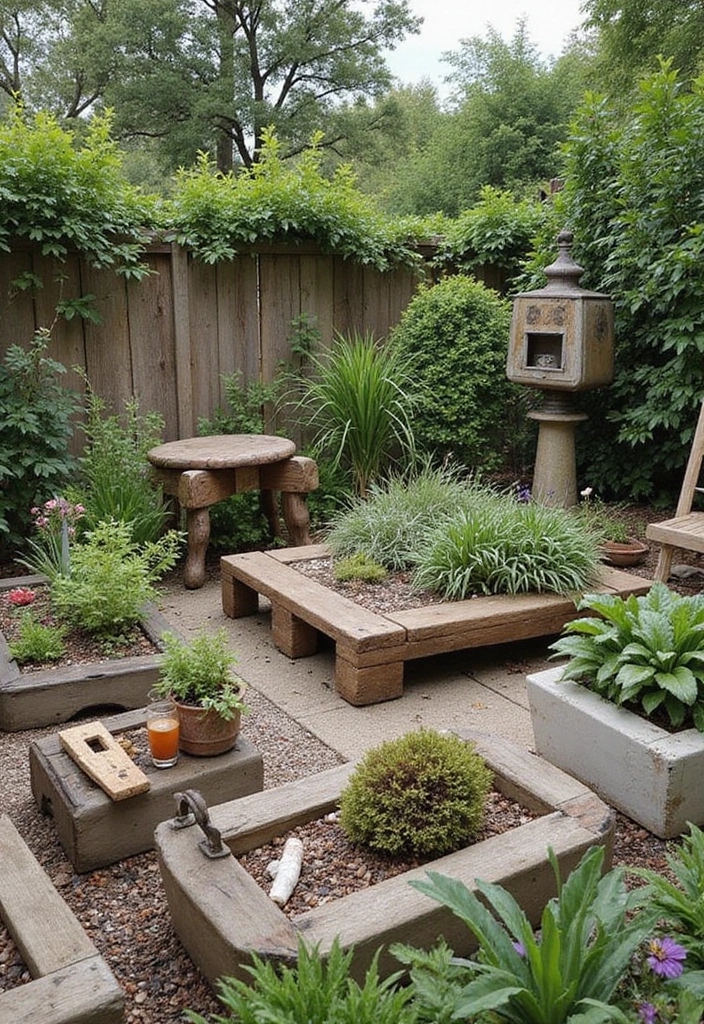
Using repurposed materials in your front garden adds a unique personality while being environmentally friendly. Old wooden pallets, crates, or even pots can be utilized in creative ways.
– DIY Projects: Get crafty and create raised beds or planters out of old furniture or pallets.
– Artistic Touches: Use old shutters, bicycle frames, or vintage items as decorative elements in your garden.
– Rustic Vibes: Incorporating distressed materials can give your garden a charming, rustic feel.
Not only will you save money, but your garden will tell a story of creativity and sustainability.
10. Small Water Features
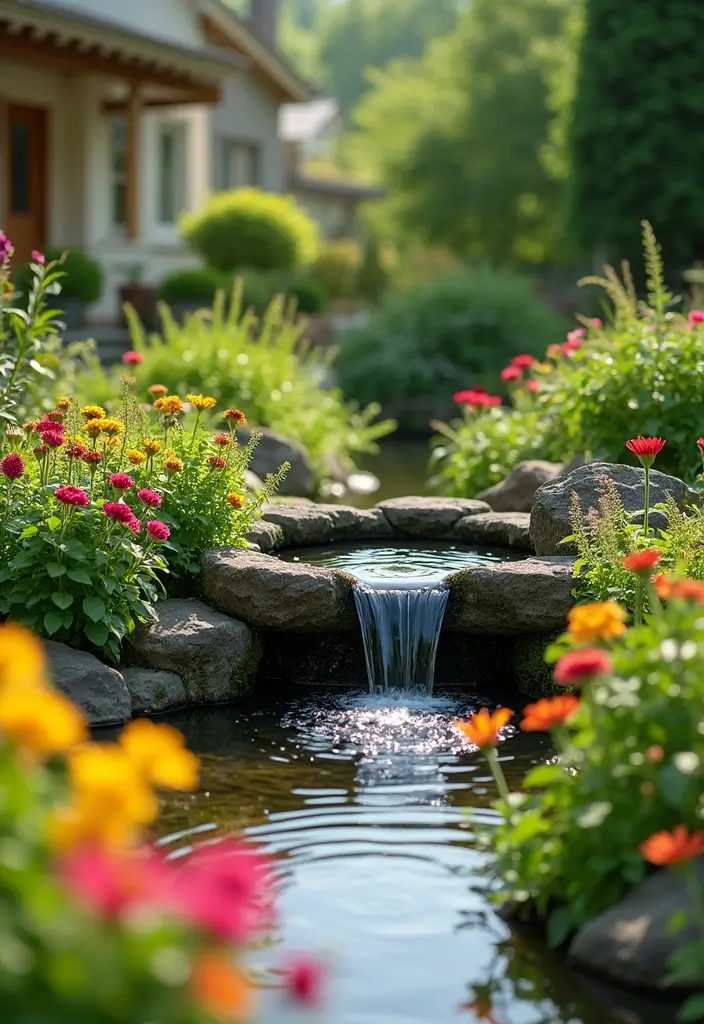
Adding a small water feature can elevate the tranquility of your front garden. The sound of flowing water can create a calming atmosphere and attract wildlife.
– Choose the Right Size: Opt for compact fountains or pondless waterfalls that fit the space.
– Incorporate Plants: Surround the water feature with moisture-loving plants to enhance the natural look.
– Use Natural Materials: Stones and pebbles can add a rustic touch while blending with the natural surroundings.
A simple water feature not only beautifies your garden but can also promote relaxation and mindfulness.
A small water feature brings serenity to your front garden, attracting both wildlife and peace. Create your oasis with just a fountain and a few lush plants – tranquility is only a splash away!
11. Seasonal Displays
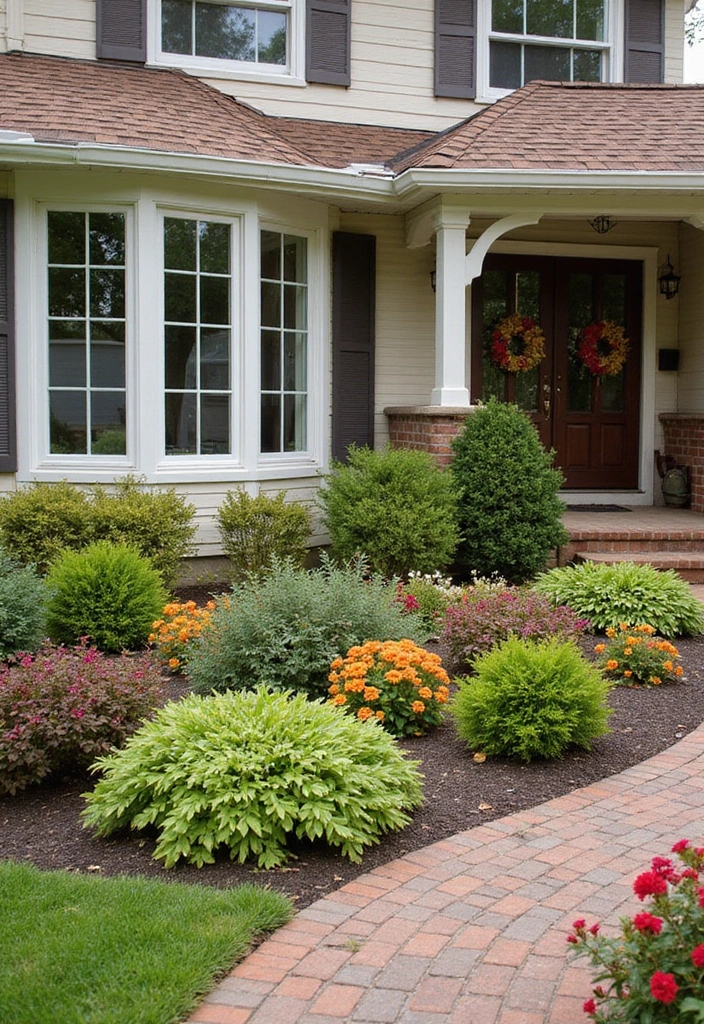
Seasonal displays offer a delightful way to keep your garden fresh throughout the year. By changing out plants or decorations, you can showcase the beauty of each season.
– Plan Ahead: Consider what will thrive in each season; for example, pansies in spring and ornamental kale in fall.
– Decorative Touches: Add seasonal decor like pumpkins in autumn or colorful Easter eggs in spring for a festive flair.
– Mixing Textures: Incorporate different materials and arrangements to reflect seasonal changes.
This approach keeps your front garden dynamic and engaging, always providing something new to admire.
12. Climbing Plants
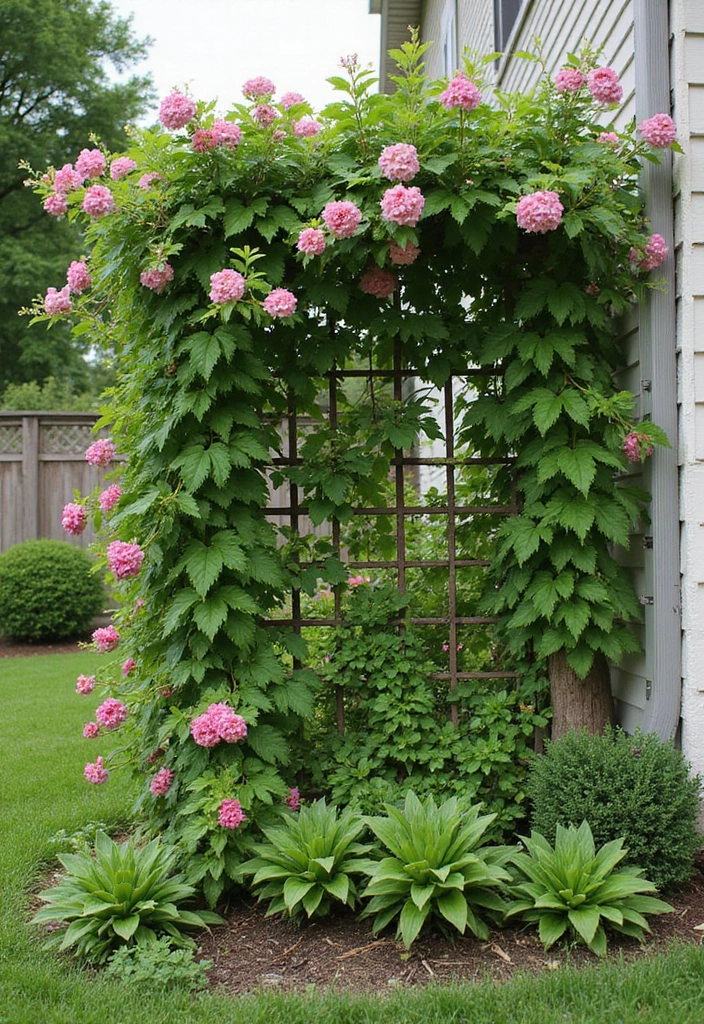
Climbing plants are perfect for maximizing vertical space in small front gardens. They can be trained to grow on trellises, fences, or even walls, adding vertical interest to your landscape.
– Choose Wisely: Select fast-growing climbers like clematis or jasmine for quick coverage.
– Support Structures: Install trellises or arbors that not only support the plants but also add aesthetic value to your garden.
– Layering: Combine climbing plants with low-growing flowers to create a stunning layered effect.
These plants add beauty and character while potentially providing shade to your porch or patio area.
13. Colorful Entrance
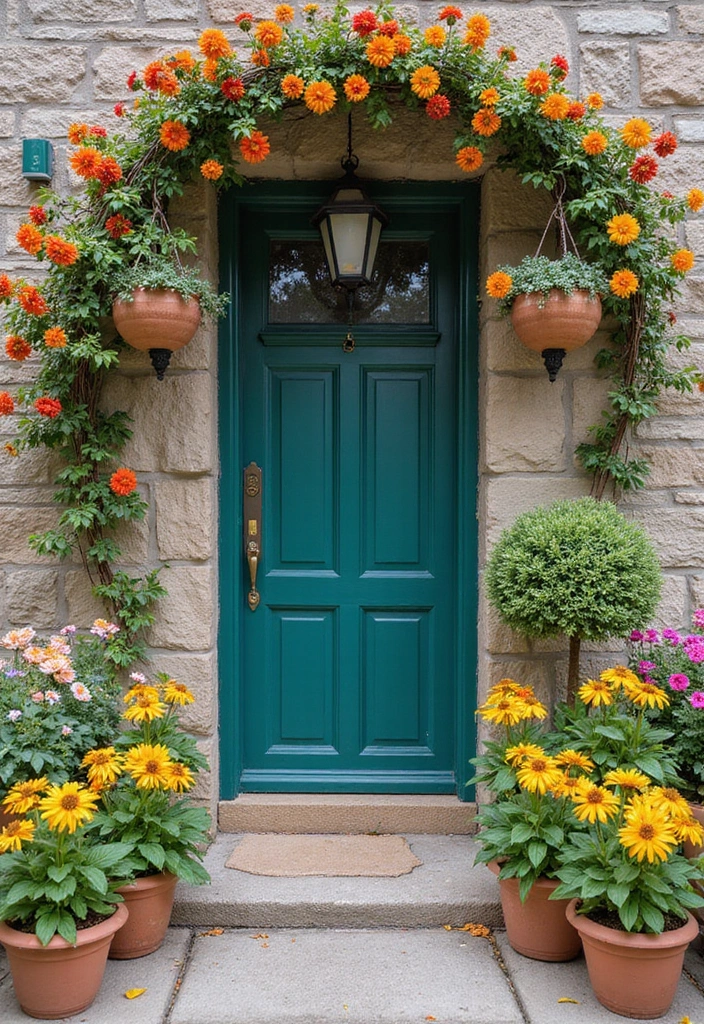
A colorful entrance can create an inviting atmosphere that sets the tone for your home. By framing your front door with vibrant plants, you create a warm welcome.
– Symmetry is Key: Use matching containers on either side of the door for a balanced look.
– Plant Variety: Combine different types of plants for color and texture; think bright geraniums alongside lush ferns.
– Seasonal Blooms: Change out plants seasonally to keep the entrance looking fresh year-round.
This colorful approach not only enhances curb appeal but also reflects your personality and style.
14. Green Lattice Screens
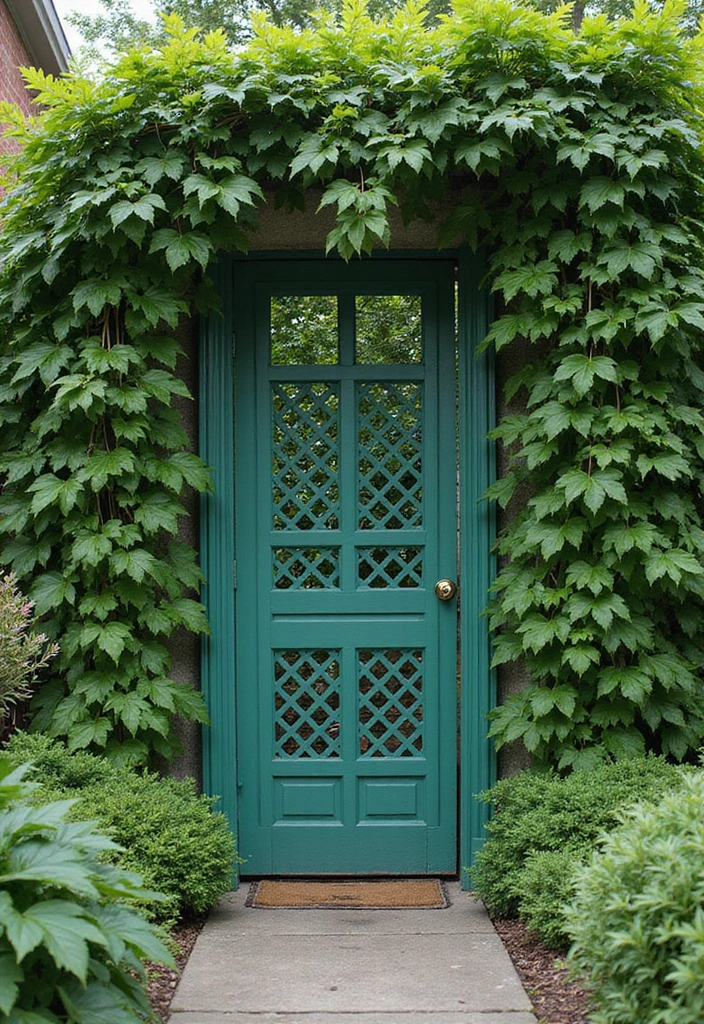
Creating green lattice screens can serve both as a decorative feature and a privacy solution in your small front garden. These screens allow climbing plants to flourish while adding texture to your garden.
– Select Climbing Plants: Use varieties like morning glories or climbing roses that can easily intertwine with the lattice.
– Create Zones: Use screens to define different areas in your garden, giving it a structured feel.
– Enhance Privacy: These screens can shield your garden from the view of passersby while still allowing light and air to flow.
Green lattice screens add elegance while ensuring your small garden feels intimate and serene.
15. Edible Landscaping
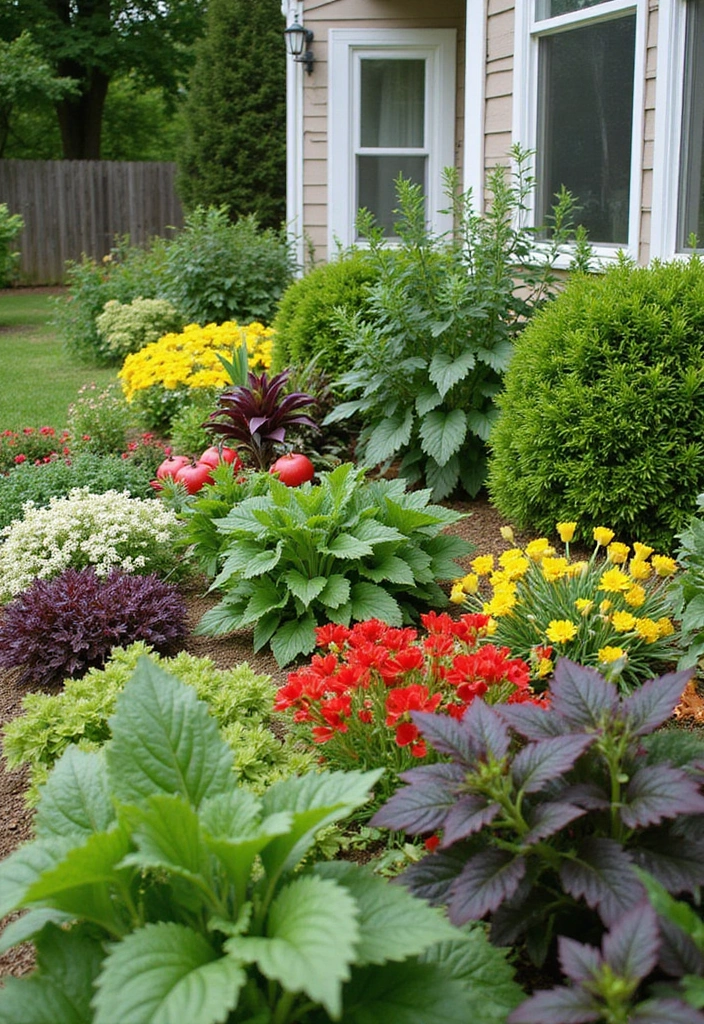
Edible landscaping combines beauty and functionality, allowing you to incorporate edible plants seamlessly into your front garden design. This approach not only provides fresh produce but also enhances your garden’s attractiveness.
– Mix Edibles with Ornamentals: Pair flowering herbs with colorful annuals to create visual interest.
– Utilize Space Efficiently: Consider growing dwarf fruit trees alongside flower beds for dual benefits.
– Visual Appeal: Experiment with vibrant vegetable varieties like rainbow chard or purple carrots that can double as decorative elements.
Edible landscaping transforms your garden into a productive space that’s as beautiful as it is beneficial.
16. Eco-Friendly Solutions
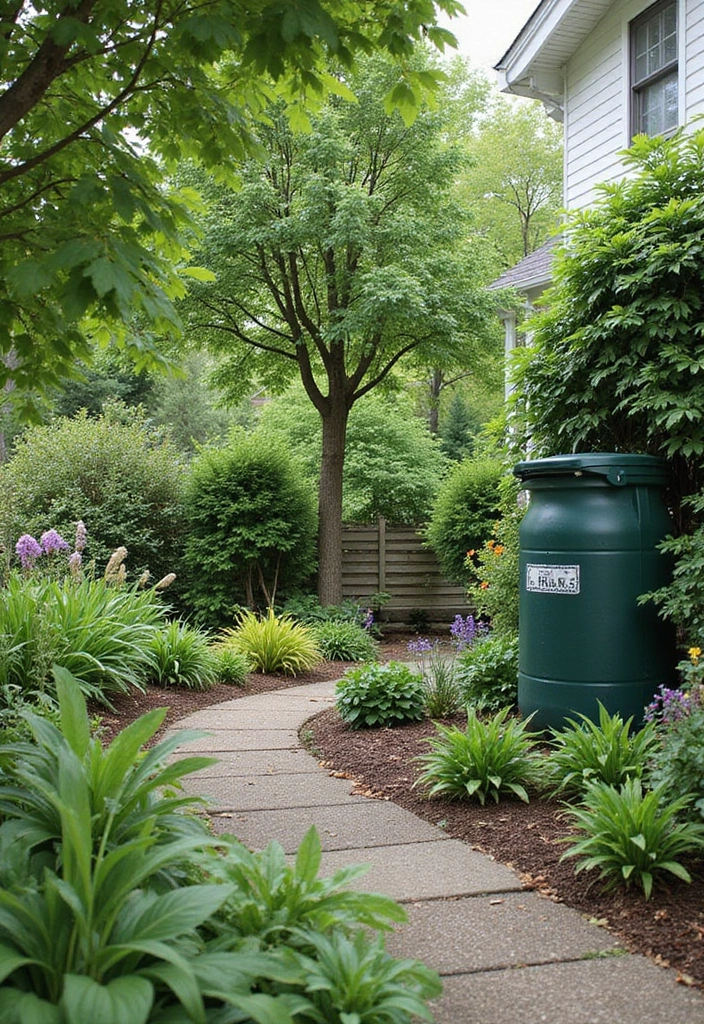
Incorporating eco-friendly solutions into your small front garden is a fantastic way to be sustainable while enhancing your outdoor space. Simple changes can make a significant impact.
– Native Plants: Choose plants that are native to your area; they require less water and maintenance, promoting local biodiversity.
– Compost Bins: Set up a small compost bin to recycle kitchen scraps into nutrient-rich soil for your garden.
– Rain Barrels: Install rain barrels to collect water for irrigation, reducing water usage and costs.
These eco-friendly practices help your garden thrive while benefiting the environment.
17. Garden Lighting
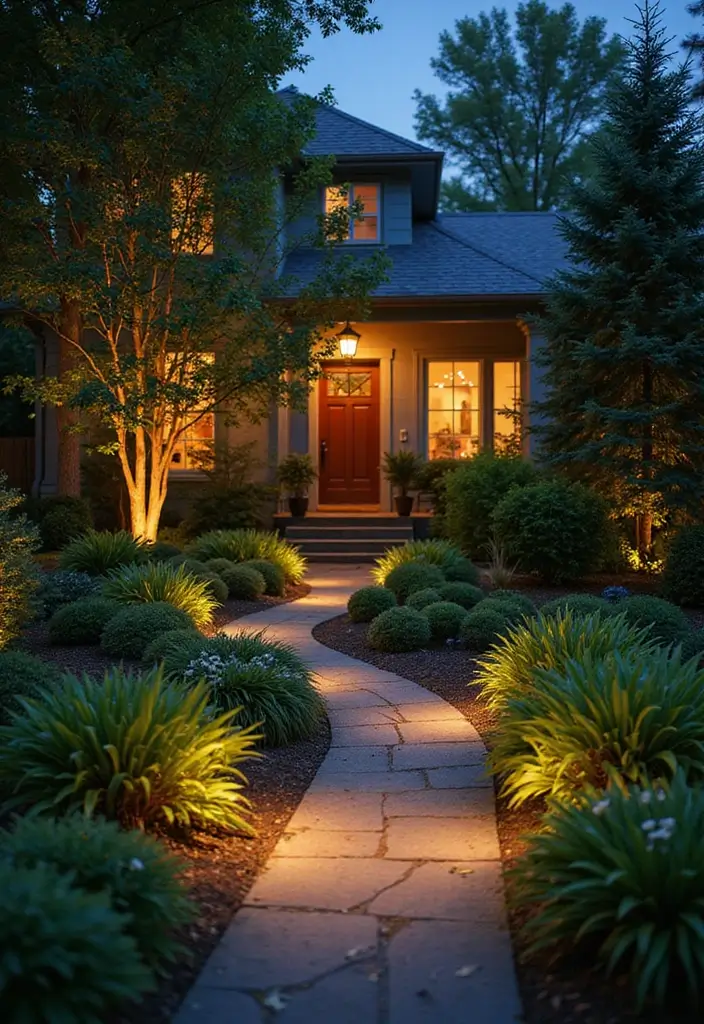
Adding garden lighting can dramatically change the ambiance of your small front garden. Lighting not only illuminates your space but also highlights key features to create an inviting atmosphere in the evening.
– Pathway Lights: Use soft lighting along pathways to guide visitors while adding a warm glow.
– Spotlights: Highlight specific plants or features, like a beautiful tree or art piece, to create focal points.
– Solar Options: Consider solar-powered lights for an energy-efficient solution that doesn’t require electrical work.
Well-placed lighting can extend the enjoyment of your garden into the evening hours while enhancing its beauty.
18. Layered Planting
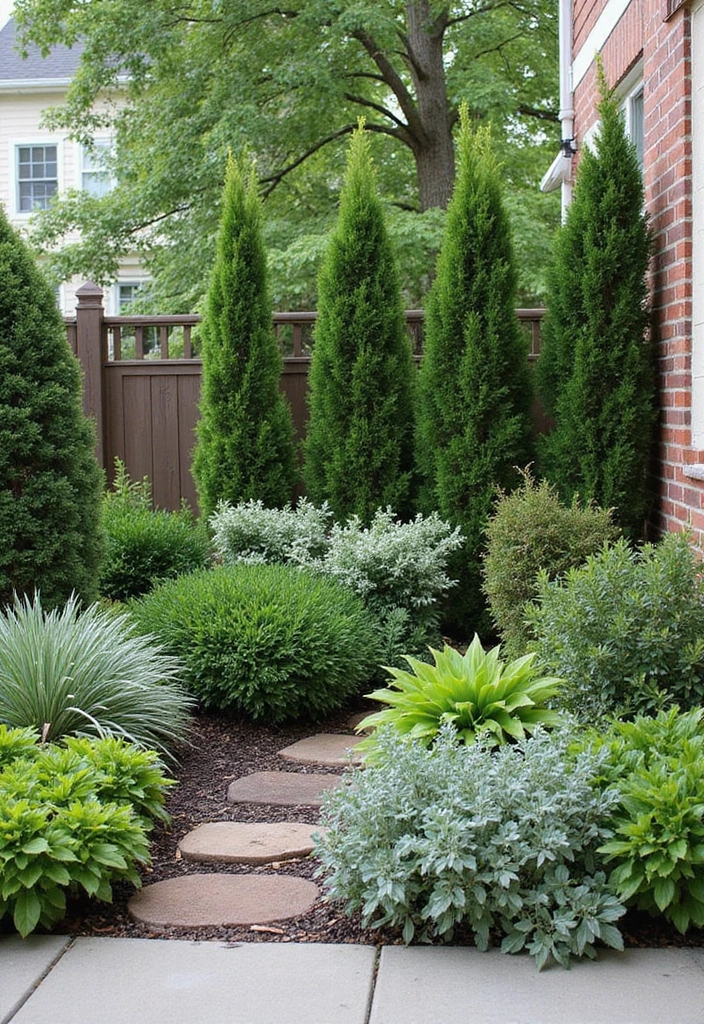
Layered planting involves arranging plants in a way that creates depth and visual interest. This technique can make your small front garden feel larger and more dynamic.
– Use Heights Wisely: Place tall plants at the back and shorter ones at the front to ensure all plants are visible.
– Mix Textures: Combine plants with different foliage textures, such as broad leaves with fine, delicate leaves for variety.
– Seasonal Variations: Incorporate plants that bloom at different times to maintain a colorful display throughout the year.
Layered planting adds complexity and beauty to your garden, making it a captivating place to explore.
19. Artistic Sculpture
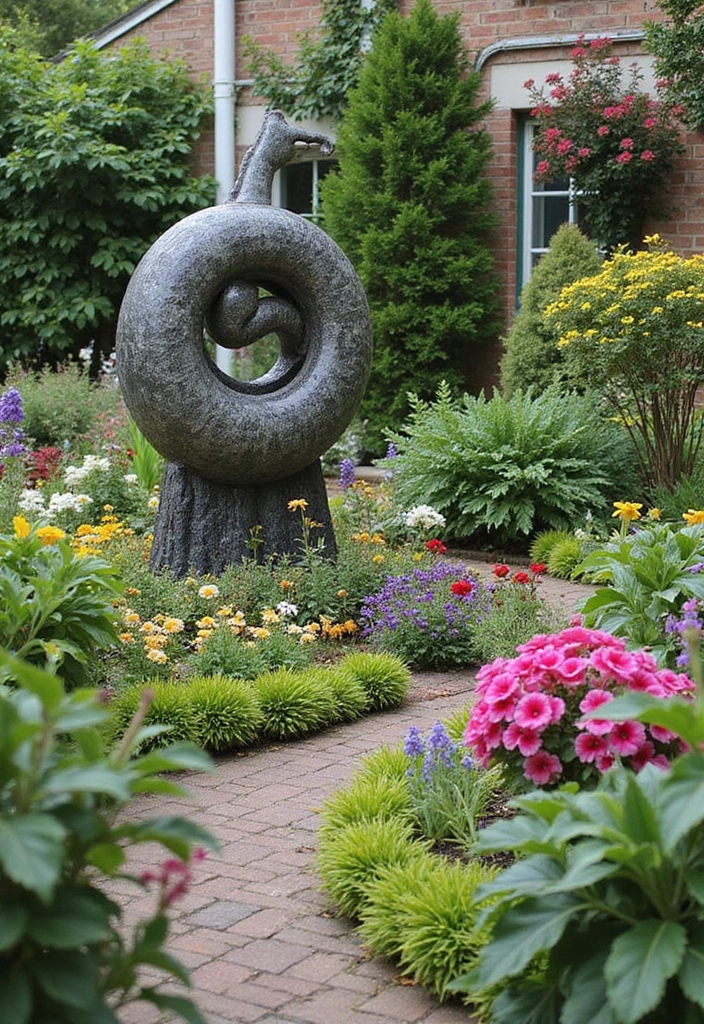
Incorporating artistic sculptures can add a unique flair to your small front garden. Sculptures serve as focal points that draw attention and spark conversation.
– Choose Complementary Styles: Select sculptures that match your garden’s aesthetic, whether modern, classic, or whimsical.
– Strategic Placement: Position sculptures at eye level or among plantings for the best visual impact.
– Blend with Nature: Use natural materials like stone or metal that harmonize with your plantings for a seamless look.
Artistic sculptures elevate your garden’s design while adding a personal touch that represents your style.
An artistic sculpture can turn your small front garden into a visual masterpiece! Elevate your space by choosing pieces that blend with nature and reflect your unique style.
20. Charming Garden Furniture
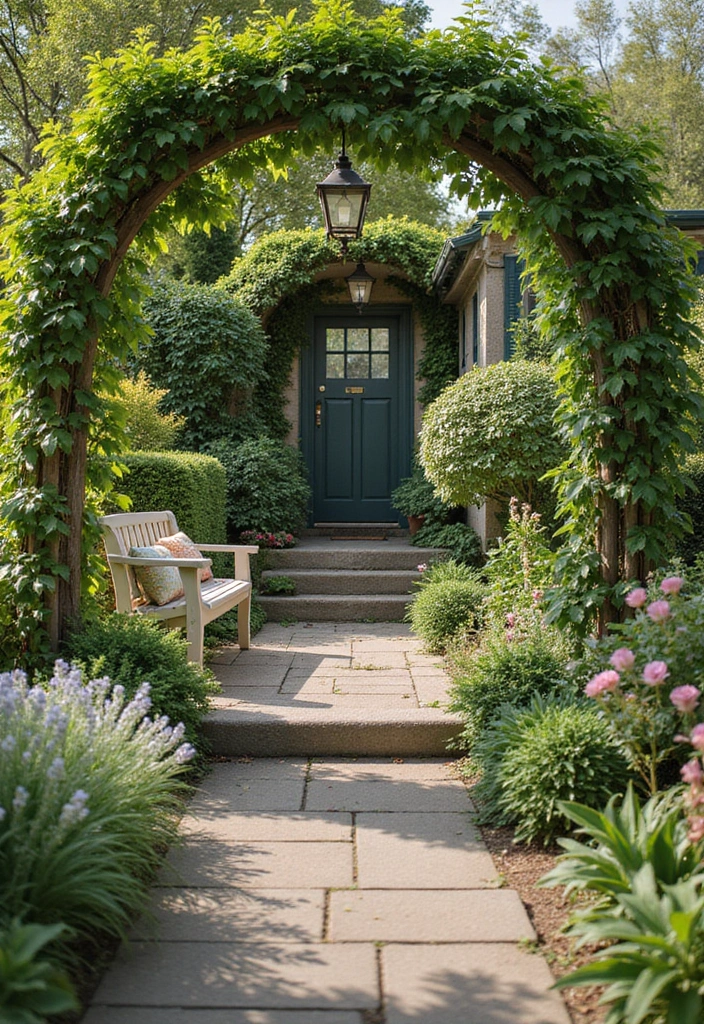
Garden furniture is more than just functional; it can enhance the overall design of your small front garden. A well-placed bench or chair can create an inviting spot to enjoy your space.
– Choose Compact Pieces: Opt for smaller, space-saving furniture to maintain flow and usability.
– Materials Matter: Select weather-resistant materials like teak or aluminum for durability.
– Accessorize Wisely: Add cushions or decorative throws for a cozy touch that encourages relaxation.
Charming garden furniture creates an inviting atmosphere and provides a functional space to enjoy the beauty of your front garden.
21. Geometric Gardens
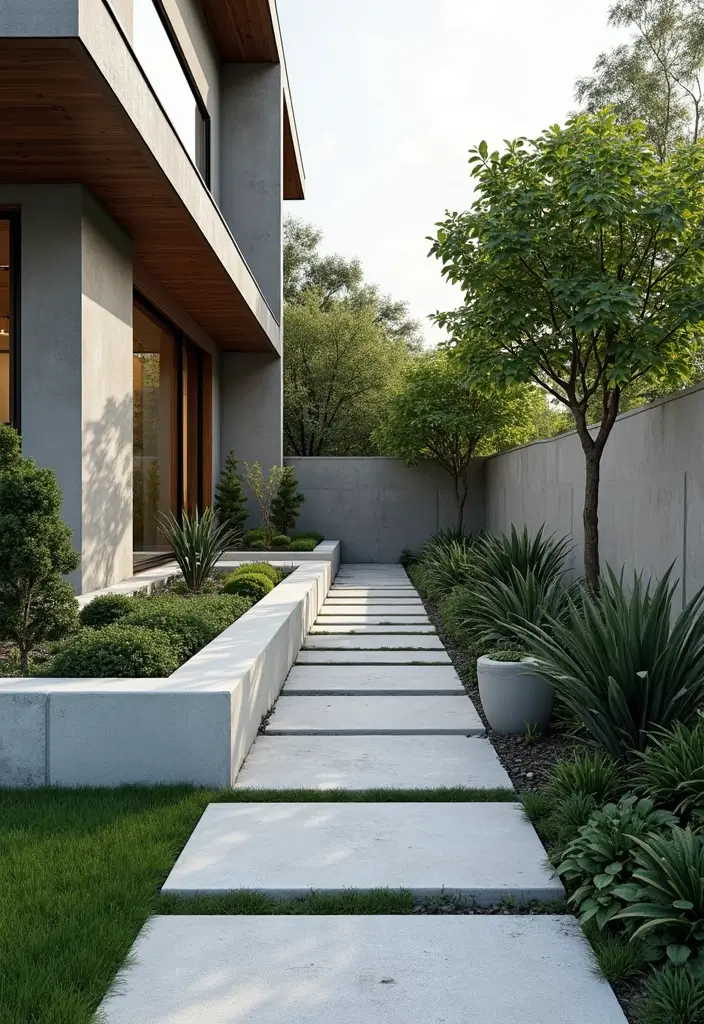
Utilizing geometric shapes in your garden design can create a modern and structured look. This approach can be particularly effective in small spaces where organization is key.
– Create Defined Edges: Use straight lines or curves to delineate different sections of your garden.
– Incorporate Shapes: Use geometric planters or garden beds to reflect the design style.
– Layer Heights: Combine plants of varying heights and shapes to enhance the geometric theme while maintaining interest.
Geometric gardens offer a sleek, contemporary aesthetic while making the best use of limited space.
22. Seasonal Color Swaps
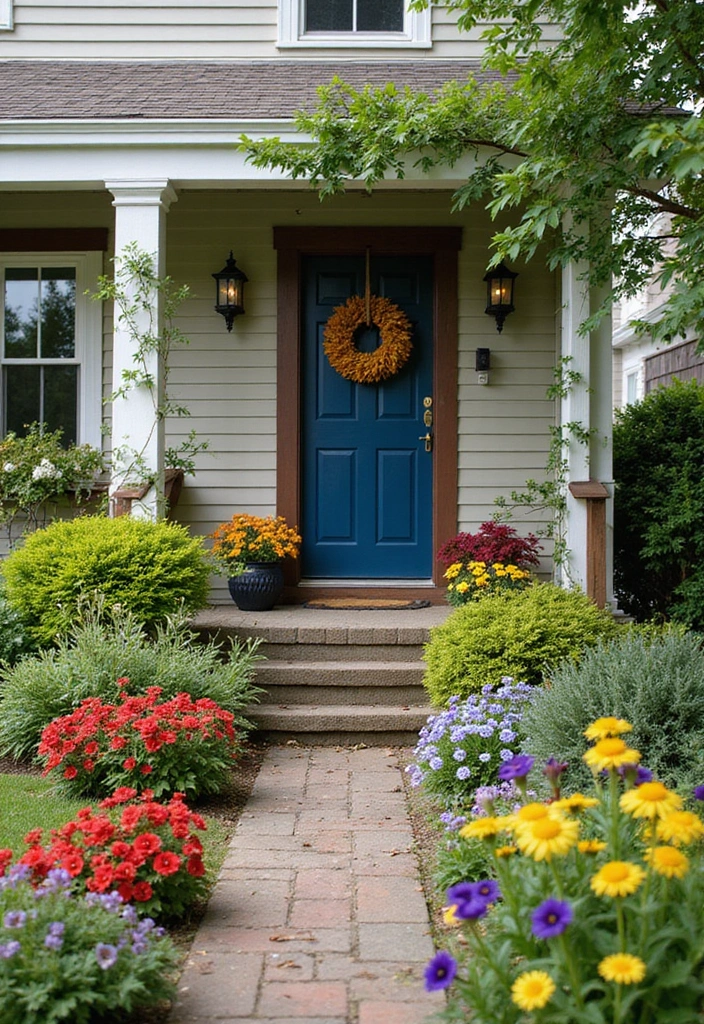
Swapping out plants seasonally is a smart strategy to keep your garden looking fresh and vibrant. Each season offers different blooms and foliage to experiment with.
– Plan Ahead: Use a seasonal calendar to know when to make changes; for example, swap out winter pansies for summer petunias.
– Mix Textures and Colors: Pair complementary plants to create dynamic arrangements that appeal to the eye.
– Use Temporary Displays: Incorporate seasonal decorative elements like pumpkins for fall or festive ornaments for winter.
This approach ensures that your garden remains a lively spectacle, year-round.
23. Natural Stone Borders
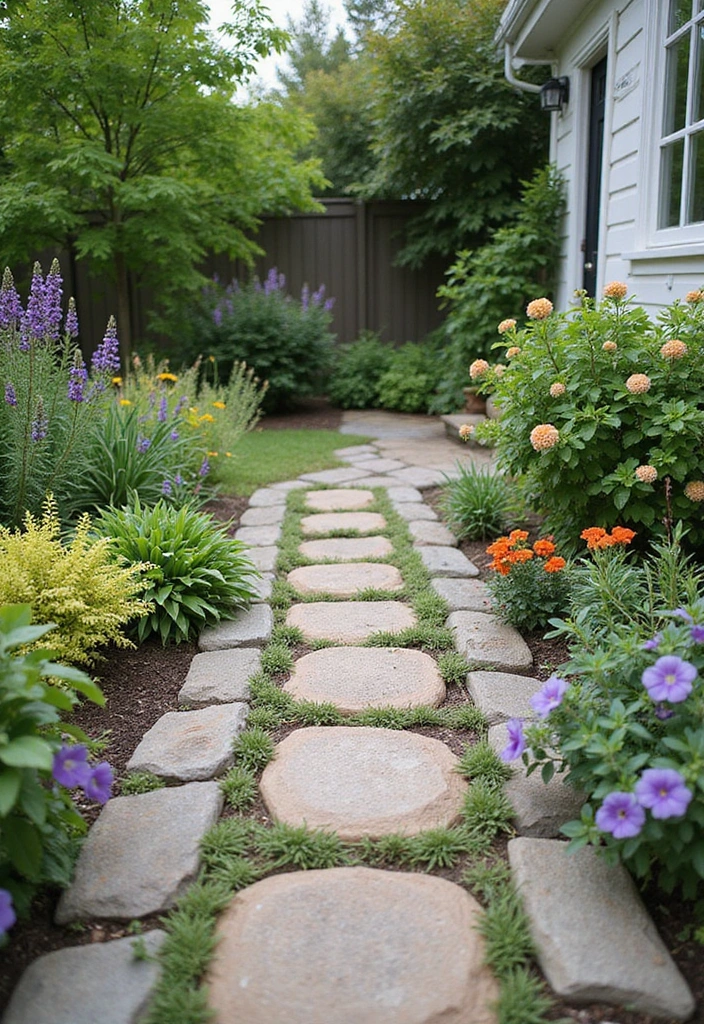
Natural stone borders can enhance the beauty of your small front garden while providing structure. They define spaces beautifully and can be used to create raised beds or pathways.
– Choose Local Stone: Selecting naturally sourced stones can add a rustic charm and connect your garden with the surrounding landscape.
– Flexible Layouts: Use stones to form curved borders for a softer aesthetic or straight lines for a more formal look.
– Integrate with Plants: Plant low-growing flowers or ground cover alongside the stones for a lush and inviting look.
Natural stone borders not only elevate your garden’s design but also create a timeless aesthetic.
24. Magical Fairy Gardens

Creating a fairy garden in your small front garden can ignite a sense of whimsy and magic. These miniature gardens offer an enchanting experience for both children and adults alike.
– Use Miniature Accessories: Incorporate tiny furniture, tiny houses, and whimsical decorations to bring the fairy garden to life.
– Choose Plants Wisely: Select small plants or ground covers that fit the theme and are easy to care for.
– Incorporate Natural Elements: Use stones, twigs, or moss to create a naturally enchanted feel.
Fairy gardens captivate the imagination while providing a charming and playful addition to your front garden.
25. Lush Ground Covers
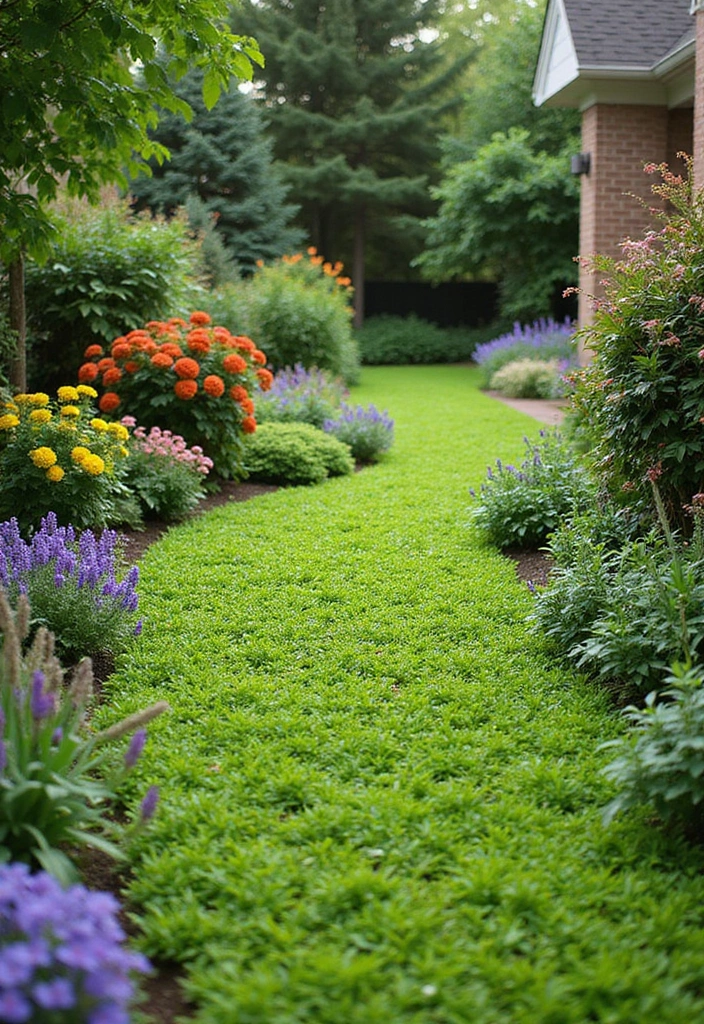
Ground covers are a fantastic way to fill in gaps in your small garden while minimizing maintenance. They provide a lush, green carpet that can enhance the overall aesthetic.
– Choose the Right Varieties: Opt for low-growing plants like creeping thyme or sedum that are hardy and visually appealing.
– Deter Weeds: Ground covers can help suppress weeds, making your garden easier to maintain.
– Enhance Texture: Mix different varieties for varied colors and textures to keep the garden lively and engaging.
Ground covers add depth and beauty while requiring minimal effort, making them a smart choice for any small garden.
26. Rustic Wood Fencing

Rustic wood fencing is an excellent way to define your small front garden while adding character. This type of fencing blends beautifully with natural surroundings and enhances the overall aesthetic.
– Choose Natural Materials: Opt for untreated wood for an organic look that complements your plants.
– Add Climbing Plants: Train vines or climbing plants to grow along the fence for a lush, green cover.
– Incorporate Decor: Hang decorative elements like lanterns or planters to give the fence personality.
Rustic wood fencing not only provides a charming enclosure but also enhances privacy while allowing your garden to shine.
Create a warm welcome with rustic wood fencing! Pair it with climbing plants for a vibrant touch, and let your small front garden shine with personality and charm.
27. Textured Grass Paths
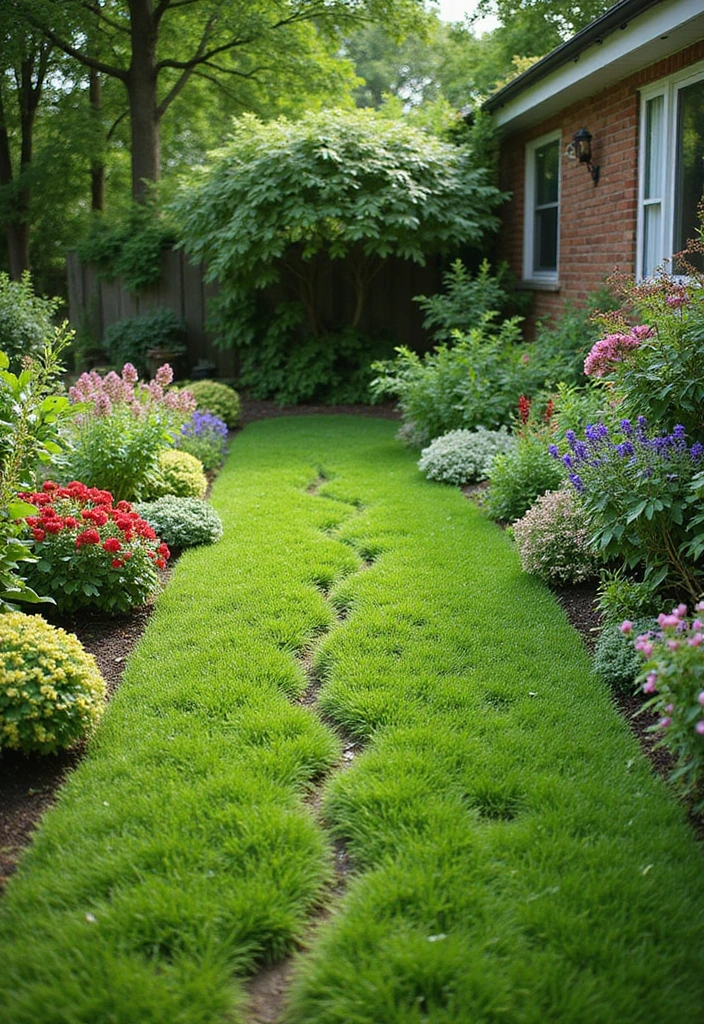
Textured grass paths can add a soft, natural feel to your small front garden while creating a clear route through the space. These paths offer a serene ambiance and blend seamlessly with your plantings.
– Choose Hardy Varieties: Use durable grass varieties that can tolerate foot traffic and thrive in your climate.
– Incorporate Edging: Define the paths with stones or timber for a clean edge that enhances visual appeal.
– Maintain Visibility: Keep the grass trimmed and well-maintained to ensure the paths remain clear and inviting.
Textured grass paths create a cozy atmosphere while guiding visitors through your garden, enhancing the overall experience.
28. Wildlife-Friendly Gardens
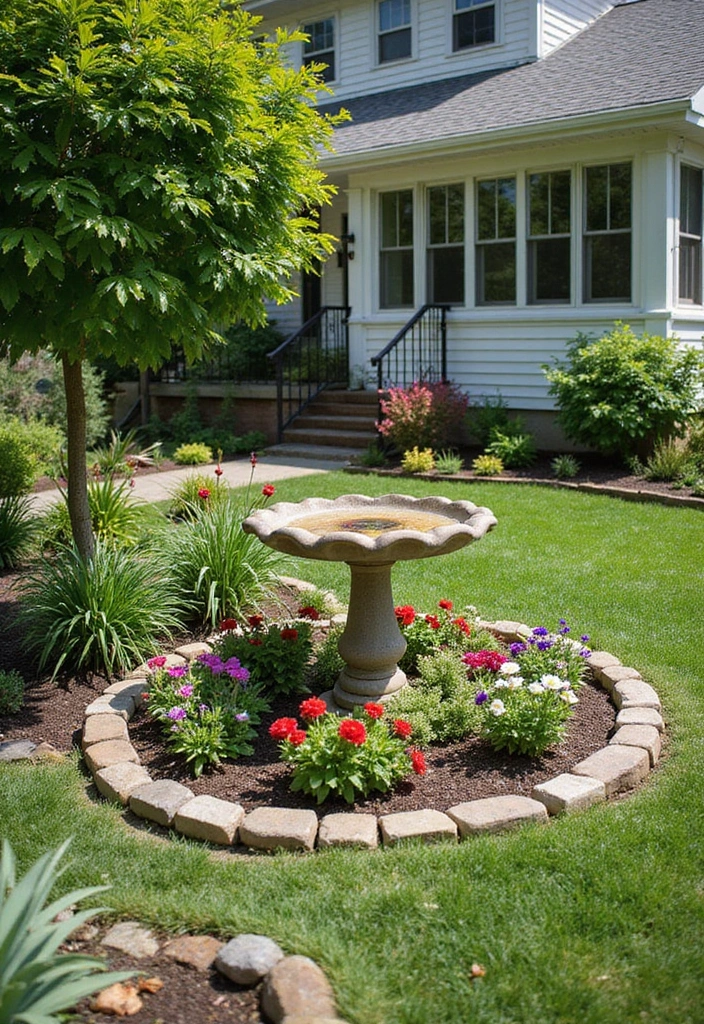
Creating a wildlife-friendly garden not only enhances the beauty of your space but also supports local ecosystems. A small garden can attract butterflies, birds, and beneficial insects with the right choices.
– Select Native Plants: Native species provide food and habitats for local wildlife, making your garden a sanctuary.
– Incorporate Water Sources: Use birdbaths or small ponds to attract birds and beneficial insects.
– Avoid Chemicals: Opt for organic gardening practices to keep your garden safe for wildlife.
A wildlife-friendly garden not only looks beautiful but also fosters a sense of harmony with nature.
29. Outdoor Art Displays
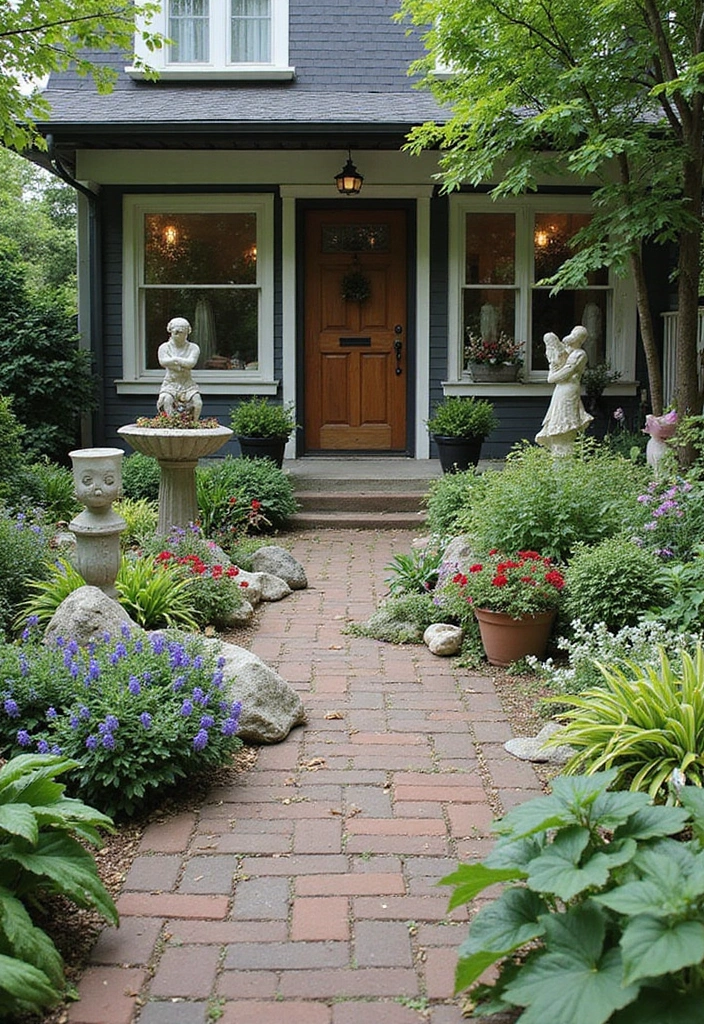
Incorporating outdoor art into your small front garden can add a personal touch and serve as a conversation starter. Art pieces can reflect your personality and enhance the overall design.
– Choose Meaningful Pieces: Select art that resonates with you, whether it’s sculptures, mosaics, or decorative stones.
– Strategic Placement: Position art pieces where they will be easily seen but won’t overwhelm the garden’s natural beauty.
– Blend with Nature: Choose colors and materials that harmonize with your plantings for a cohesive look.
Outdoor art displays create a unique atmosphere while enriching your garden experience.
30. Unique Plant Shapes
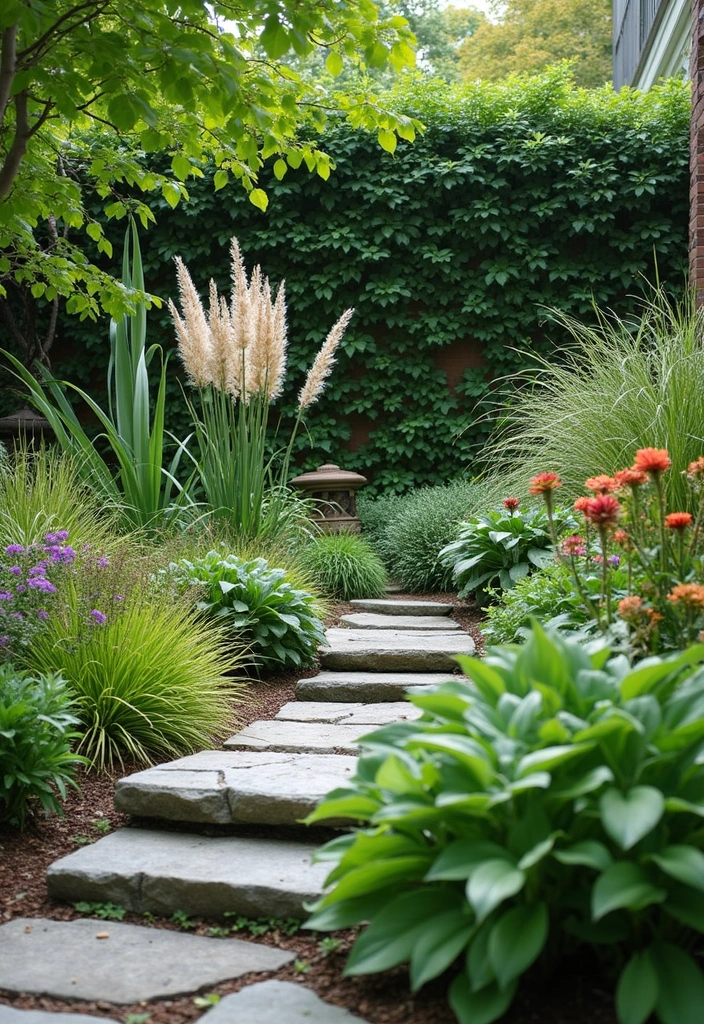
Focusing on unique plant shapes can add a striking aesthetic to your small front garden. By selecting plants with interesting forms, you can create visual interest even in limited space.
– Experiment with Foliage: Look for plants with unique leaf shapes or textures, such as ornamental grasses or architectural succulents.
– Incorporate Trees: Even small, sculptural trees can make a statement in an otherwise compact area.
– Vary Heights and Sizes: Mixing plants of different sizes and shapes can create dynamics in the layout.
Unique plant shapes not only add character but also draw the eye, making your small garden stand out beautifully.
Conclusion
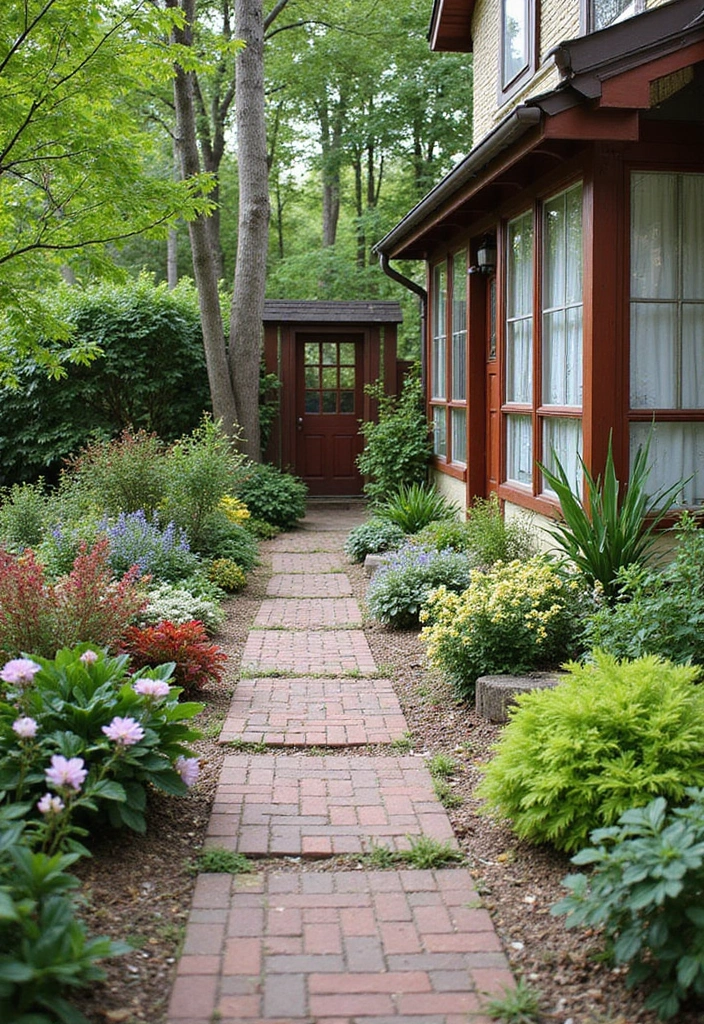
Transforming your small front garden into a stunning space can be a fun and rewarding experience. With these 30 small front garden ideas, you can create a visually appealing and functional project that reflects your personal style.
No matter your gardening skill level, these ideas offer plenty of opportunities for creativity and innovation. Now, it’s time to roll up your sleeves, get planting, and enjoy the beauty your front garden will bring!
Frequently Asked Questions
What are some creative ideas for small front garden designs?
If you’re looking to make a big impact in a small space, consider using vertical garden panels or tiered planting beds. These options not only save ground space but also add visual interest. You can also incorporate container gardening, which allows you to mix and match different plants and colors for a personalized touch.
Don’t forget about decorative pathways and wall-mounted planters to further enhance your garden’s curb appeal!
What low-maintenance plants are suitable for small front gardens?
For a low-maintenance front garden, consider plants like succulents, ornamental grasses, or native plants that thrive in your local environment. These options require minimal care and can survive with little water. Pair them with ground covers to fill in gaps while keeping maintenance low. Remember, a well-planned garden can be both beautiful and easy to care for!
How can I improve the curb appeal of my small front yard?
Improving your curb appeal starts with choosing the right plants and organizing them effectively. Use colorful plant combinations near your entrance to create an inviting atmosphere. You can also add decorative features like garden lighting or artistic sculptures to draw attention. A well-defined pathway can guide visitors while enhancing the overall aesthetic of your space. Small details can make a big difference!
What are the benefits of vertical gardening in small spaces?
Vertical gardening is a fantastic solution for small front gardens! It maximizes your growing area without taking up valuable ground space. You can grow a variety of plants, including herbs and flowers, on wall-mounted systems or trellises. Additionally, vertical gardens can provide privacy and shade, making your space feel more inviting. Plus, they add a unique aesthetic that enhances your garden’s charm!
How can I create a seasonal display in my small front garden?
Creating a seasonal display is a wonderful way to keep your garden looking fresh year-round. Start by planning ahead and choosing plants that bloom in different seasons. Use container gardening to easily swap out plant varieties as the seasons change. Incorporating seasonal decorations, like festive colors or themed ornaments, can also enhance your garden’s appeal during holidays. This approach not only showcases seasonal beauty but also keeps your garden dynamic and exciting!
